The Ring of Remembrance, Notre Dame de Lorette
Updated: 2014-12-04 14:53
By JONATHAN GLANCEY(China Daily USA)
|
|||||||||
Architect Philippe Prost's new International Memorial of Notre Dame de Lorette is as beautiful as it is moving.
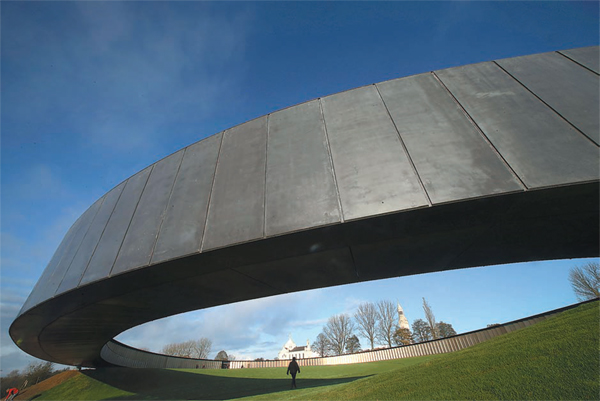 |
|
The new war memorial at Notre Dame de Lorette, an elliptical ring engraved with the names of the 580,000 men who died in northern France during the First World War, in Ablain-Saint-Nazaire on Nov 5, 2014. PHOTO BY PASCAL ROSSIGNOL / REUTERS |
The morning sun picks out and burnishes hundreds of thousands of names engraved on an ellipse of tall and regimented gold metal sheets. It rises to salute the Asbachs and Behrens, Bartons and Beastons, the Adolfs and Alfreds, Roberts and Johns, the Georges and the Jean-Baptistes slaughtered in the Nord-Pas-de-Calais during the Great War.
They are all remembered in the compelling new International Memorial of Notre Dame de Lorette, a “Ring of Remembrance” at Ablan Saint Nazaire north-west of Arras, due to be inaugurated on November 11 by President Hollande accompanied by Chancellor Merkel and David Cameron.
Among so many German, French and British names, my fingers trace that of Gabar Sing [sic] Negi VC, 21, of the 2/39th Garwhal Rifles. Born and brought up in sight of the Himalayas, he died here four thousand miles from home in what soldiers on all sides knew as the “cemetery” of Flanders and the Artois, and news reporters as “Hell in the North”.
And, here, is “Katherine Maud McDonald”, a 25-year-old nursing sister from Brandford, Ontario – some four thousand miles from Arras – killed in an air attack on the 1st Canadian General Hospital in May 1918.
This new 8-million euro memorial takes the form of a 328-metre ring of dark, lightweight concrete barely touching and, as if by magic, projecting over a plateau set below the neo-Byzantine chapel and soaring lantern tower of the National Necropolis, the biggest of all French military cemeteries. Inside the ring, 500 sheets of bronzed stainless steel list 579,606 names. Beyond the memorial’s precisely defined boundary are far stretching views of seemingly uneventful countryside.

Hard to believe now, this was once the heart of France’s coal-mining industry, a strategic target for attacking German armies. It’s hard to believe, too, that these green farmlands – poppy-strewn in summer – were once churned into an ooze of mud and blood by an estimated 1.5 billion artillery shells.
“To give shape to brotherhood, to unite yesterday’s enemies,” says Philippe Prost, the memorial’s architect, “I chose the ring as a figure to bring together the names of the soldiers, thinking of the circle formed by people holding hands. The ring is synonymous with unity and eternity. Unity, because the names form a sort of human chain, and eternity because the letters are joined without an end, in alphabetical order without any distinction of nationality, rank or religion.”
Invention and engineering skill as well as a lightness of artistic touch has made this apparently simple war memorial both special in its own right and comparable, even though so very different, to both the most revered First World War memorials in France and Belgium and to those witnessing the loss of life in later wars. What these share is the power to move people across time, nationality, class and religious background.
Sir Edwin Lutyens’s Memorial to the Missing of the Somme at Thiepval is the biggest and greatest of British war memorials, a monumental gateway commanding remote countryside in a gloriously complex sequence of interlocking arches. It records the name of 72,195 British and South African soldiers with no known grave. Coming across it, especially in low light and mist, is a haunting and unforgettable experience. All those missing soldiers stand with you.
Maya Lin’s simple and beautiful Vietnam Veterans Memorial in Washington DC might appear to be utterly at odds with Lutyens’s at Thiepval, and yet Lin’s twin walls of reflective stone record the names of 58,272 US soldiers lost in Vietnam. People come here to feel these with their fingertips. Ultimately, it is the same when you get close to the Thiepval memorial: what you see is not so much sublime architecture, but all those names carved in heartbreaking profusion.
And, yet, perhaps the most beautiful of all war cemeteries are the simplest of all, notably the German cemeteries at Vladslo and Langemark near Ypres designed by the architect Robert Tischler, a former Great War soldier. In these, names are recorded on simple granite stones set like patterns in a carpet on grass stretching every which way under oak trees: man and nature, mourning and universal life married beautifully and forever.
Not all British observers will necessarily agree with Dr Markus Meckel, President of the German War Graves Commission, who says, “It is in places such as Notre Dame de Lorette that we can and must assert loud and clear that the European Union is more than just a financial and economic programme. It is a major step towards peace and reconciliation which must not just be preserved and developed but which represents all our futures”. And, yet, in Prost’s beautiful design, as in all those soldiers’ deaths, we are truly united, even if we are never free of the politics that causes such horrific wars.
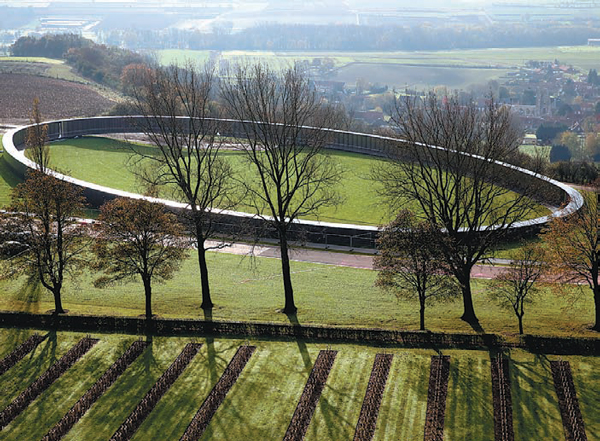 |
|
The memorial, paying respect to soldiers of all nationalities who perished in this land between 1914 and 1918, is on the edge of the Notre-Dame de Lorette French war cemetery. PHOTO BY PASCAL ROSSIGNOL / REUTERS |
(China Daily USA 12/04/2014 page10)
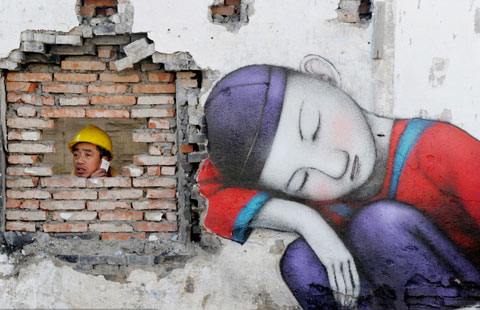
 Last artistic flourish in neighborhood to be demolished
Last artistic flourish in neighborhood to be demolished
 Parents 'see' through the eyes of their child
Parents 'see' through the eyes of their child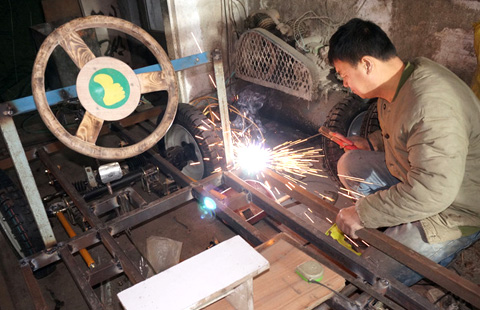
 Carpenter carves armored vehicle from wood
Carpenter carves armored vehicle from wood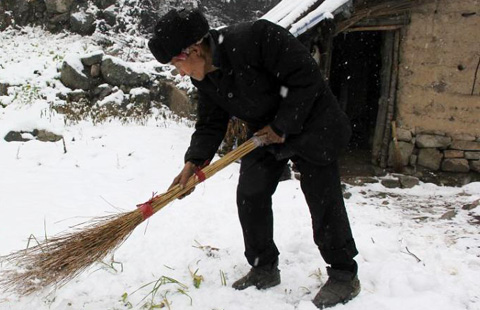
 Reclusive old men in the Qinling Mountains
Reclusive old men in the Qinling Mountains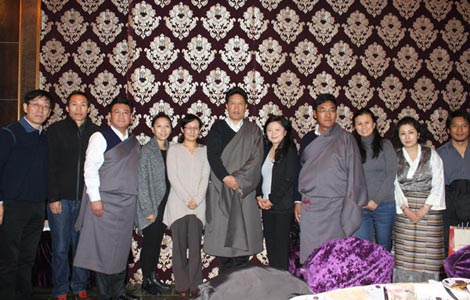
 Greetings from Tibet
Greetings from Tibet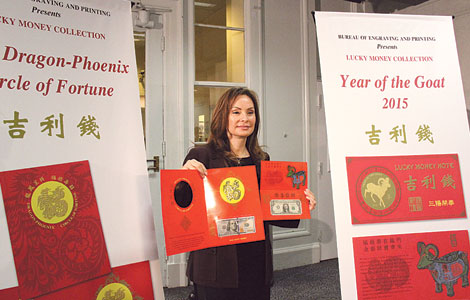
 A buck to the Year of the Goat
A buck to the Year of the Goat
 China-US Internet Forum in DC
China-US Internet Forum in DC
 Shanghai native creates mini car by hand
Shanghai native creates mini car by hand
Most Viewed
Editor's Picks

|

|

|

|

|

|
Today's Top News
Obama upbeat on future of US-China ties
Opening minds through film
Meet an original Bambi artist, 104
Gay dating app in China gains funding
US startup a good fit for China electronics player
93% of Chinese govt websites have security loopholes: report
2014 likely to be warmest year
Blending of cultures benefits world
US Weekly

|

|








